| Designer: Rancho Santa Ana Botanic Garde | Garden Tours: Rancho Santa Ana Botanic Garden |
Photographer: GardenSoft |
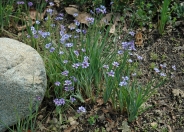
Common name: Blue-Eyed Grass
Botanical name: Sisyrinchium bellum
Following winter rains, this grassy perennial brings a soft texture back into the garden. It produces an abundance of small blue-purple flowers which have a long bloom cycle. The foliage is similar to Irises. This California native prefers full sun and is drought tolerant once it's established. It's great in small spaces and among rocks. This plant reaches about 1' tall.
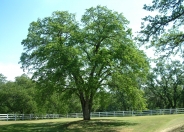
Common name: Valley Oak
Botanical name: Quercus lobata
The Valley Oak is a large deciduous tree that can quickly reach 20' tall in 5 years, then another 20' tall in the subsequent 5 years. Then this majestic California native slows down in growth, becoming more vase-like in habit, until reaching 60' tall in 20 years. Thus, not a good choice for residential homes. Leaves are deeply lobed and gray green, fuzzy, with underneath a pale green. Leaves turn yellow, then orange, then brown during the fall. Flowers appear in spring but are considered insignificant, followed by acorn fruit. Young trees have a pewter colored trunk, changing to dark gray with fissures and branches that are drooping. This tree does best in areas with a high water table. It attracts squirrels and birds. It does tolerate fires. It can reach 600 years old if roots have access to water table. Also known as: Calif. White Oak, Roble
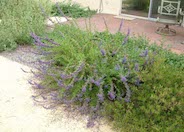
Common name: Woolly Blue Curls
Botanical name: Trichostema lanatum
Woolly Blue Curls is an evergreen shrub that reaches 3'-5' high. It has an open branching habit and has long stalks of brilliant purple woolly flowers in the spring and summer. This California native, is drought tolerant, and attracts hummingbirds. It puts on a dramatic display of purple stealing the show when in bloom. This is a highly prized compact, medium sized shrub that produces breath-taking deep purple to blue flowers. This shrub prefers minimal watering after establishment, well drained soil and plenty of sun. It naturally occurs below 2000' ft. Woolly Blue Curls grows fast, reaching about 4 ft in height and the same in width. The leaves are needle like, thick skinned points that are a light to dark green. The spring and summer flowers are loved by bees, hummingbirds, butterflies, and a favorite of Native gardeners. This very hardy, drought tolerant native was extremely important to indigenous Americans, who used almost all parts of the plant for medicinal uses, especially for stomach ailments. Indeed, it became so important that it was used as a currency at times. Tea made from sprigs of Woolly Blue Curls is also extremely tasty, with a soothing, calming effect.
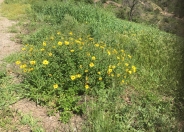
Common name: Coast Sunflower, Coast Encelia
Botanical name: Encelia californica
Encelia californica is a fast growing, woody shrub with bright green foliage and yellow daisy-type flowers that bloom from spring through summer. It can be used effectively in just about any landscape with regular or occasional pruning to maintain form. In inland situations, it requires more regular water during summer to look better. It grows to 3'-5' tall and wide. This plant attracts bees and butterflies in abundance. It does best in coastal areas from which it is native. It is a short lived plant but makes up for its shorter life with more color than most plants.
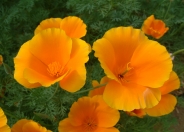
Common name: California Poppy
Botanical name: Eschscholzia californica
The California State Flower. This small annual (sometimes acts as a perennial) plant will grow to less than 1' tall and has light, small blue green leaves with gold and orange flowers that bloom in spring and summer. It is an aggressive grower and can get away from you in a residential garden space. Plant it in spaces where it is alright for it to roam.
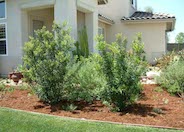
Common name: Pacific Wax Myrtle
Botanical name: Myrica californica
This large shrub/tree can reach 30' tall and has glossy, dark green leaves with purple nutlets that attract birds. It is used very effectively as a screen. Also known as Morella californica.